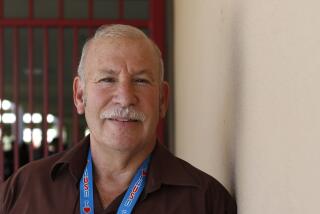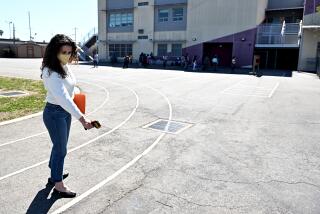Hope for our schools
The Public School Choice Resolution, approved by the Los Angeles Board of Education in August, offers a potential lifeline to neighborhoods with failing schools and few alternatives.
It will allow charter school operators, unions, teacher collaboratives, universities and other nonprofit innovators to submit proposals to take over low-performing schools -- as well as some of the district’s newly constructed school buildings.
A competitive process to bring in new school management from outside the district makes a lot of sense, especially given the LAUSD’s less-than-stellar track record for launching and running new schools. (Remember the district’s disastrous 2005 opening of the Santee Education Complex? The school was built at a cost to taxpayers of nearly $100 million, yet, at the end of its first year, Santee’s test scores were the lowest of any regular high school in the district.)
The Public School Choice Resolution is a big step in the right direction. Past experience, however, makes me skeptical as to whether the LAUSD will take full advantage of this window for change. Everyone in Los Angeles who has a stake in better schools needs to work together to make sure this isn’t another wasted opportunity.
Here’s some advice from a concerned but enthusiastic supporter:
* The superintendent of schools should hire a strong leader and team to execute this effort. The team must spend every minute of every day on the project. Other major cities that embarked on similar new school initiatives -- most notably New York and Chicago -- created new divisions staffed with extremely bright, mission-driven individuals who worked hard to bring about success. If the LAUSD cannot afford additional salaries right now, it should reach out to private foundations for help.
* The district needs to ensure that proposals are judged on merit, not politics. Special interests cannot be allowed to block progress. Last week, the superintendent revealed plans to ask teachers at the lowest-performing schools to vote on restructuring proposals for their own campuses. Although well-intentioned, this is a flawed idea. How can the district expect teachers to cast “objective” votes when their jobs may be at risk?
* In considering proposals, the LAUSD should keep in mind the goals it has already articulated. In June 2008, for example, the board passed a resolution mandating that all low-performing schools be transformed into clusters of small schools, each with no more than 500 students. New schools were similarly mandated to be built as clusters of small schools rather than as huge institutions. This resolution aimed to increase principal, teacher and student interaction, but the bold vision was never fully realized. Now there is an opportunity to revitalize this policy.
* Some members of United Teachers Los Angeles have expressed fears that the LAUSD will become “charterized” as a result of the Public School Choice Resolution. Teachers should instead view the school-choice resolution as an opportunity to submit their own proposals and create the kinds of schools they believe would best serve students. Charter schools are teachers’ allies, not their enemies.
* All new school operators should be given the same authority charter schools have. This includes the power to hire and fire, fair per-pupil funding allocations, scheduling flexibility and curriculum control. If the LAUSD does not provide the new operators with autonomy, the schools will have a hard time succeeding.
* Thousands of parents showed up in support of the Public School Choice Resolution. Now they have an important role to play during the transition. They need to hold school board members accountable. They need to get angry about inferior education.
With luck, the board’s resolution will be just a beginning. Soon, any school that’s below par should be fair game for takeover. The district must allow selected operators the freedom to create “new starts” at these low-performing schools. Simply bringing in new management, while keeping the same staff and curriculum, will not be enough.
I have tried for more than a quarter of a century to improve the LAUSD’s schools through my philanthropic and political roles. And I have been frustrated again and again. There is finally real hope for transforming our city schools and closing the achievement gap. But it will take the unions, the parents, the school board and the school district joining together to make this happen.
More to Read
Sign up for Essential California
The most important California stories and recommendations in your inbox every morning.
You may occasionally receive promotional content from the Los Angeles Times.










